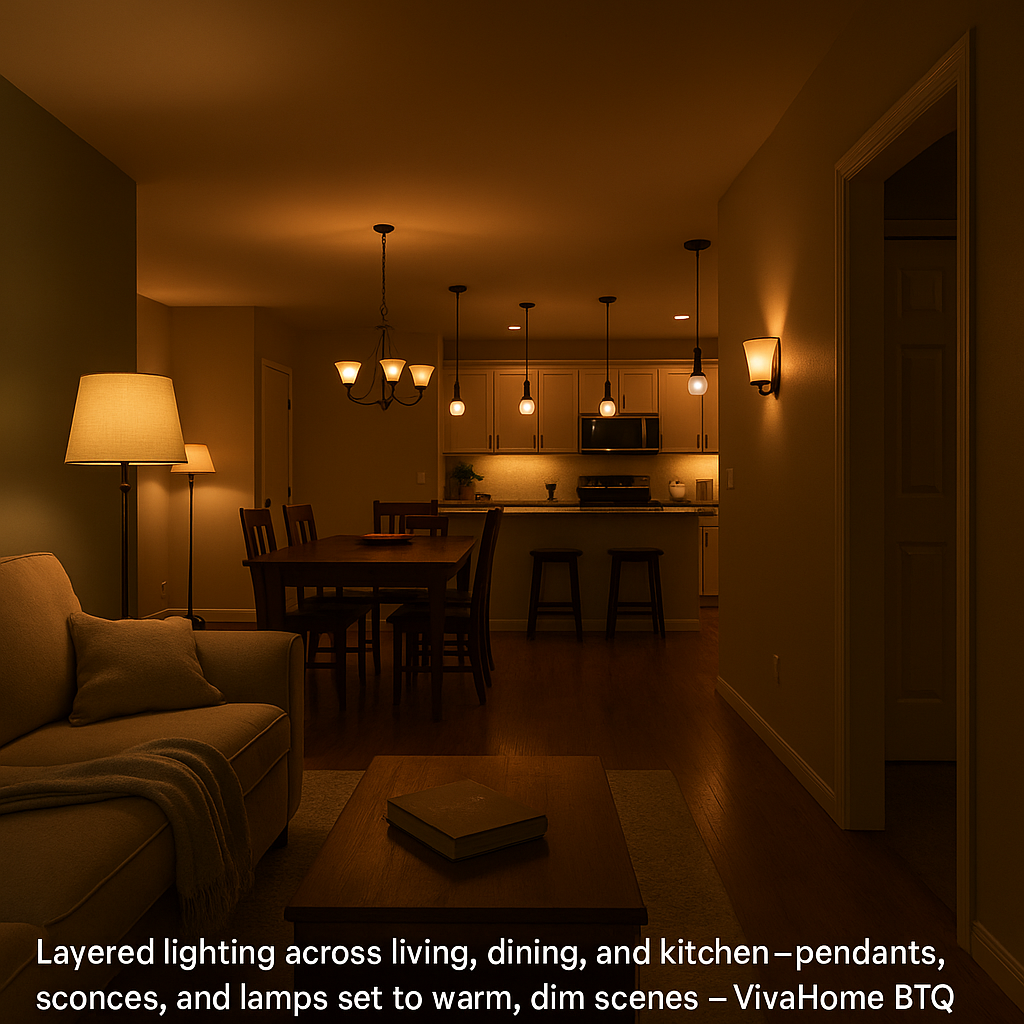
Light Like You Mean It: A Room-by-Room Layered Lighting Blueprint (Lumens, Kelvins, Heights & Dimmers) | VivaHome BTQ
Share
Prologue
Light is the quiet architect—the difference between a room that merely contains furniture and a room that receives you. We aren’t chasing glare or novelty. We’re composing layers—ambient for breath, task for work, accent for grace—then tuning them with the right lumens, Kelvin temperature, and dimmers so evenings land softly and mornings begin with conviction. This is an exact, room-by-room blueprint.
1) First Principles: The Three Layers (and the numbers that matter)
-
Ambient (general wash): ceiling lights, large pendants, floor lamps; aim 20–30 lumens per sq ft in living/bed, 30–40 in kitchens/baths.
-
Task (focused work): desk/reading lamps, island pendants, under-cabinet strips; target 500–700 lux at the surface (roughly 450–800 lumens per fixture depending on distance).
-
Accent (character & depth): sconces, picture/spot lights, backlighting; small doses at 2700–3000K create warmth.
Color Temperature (Kelvin) guide
-
2700–3000K: warm, evening rest, living/bed/restaurant calm.
-
3000–3500K: neutral-warm, great all-day default.
-
4000–5000K: crisp task/proofing; use sparingly after dusk.
Must-haves: dimmers (for every primary circuit), high-CRI bulbs (90+) for accurate color, layer control via separate switches or smart scenes.
2) Living Room: Conversation First, Screens Second
Targets
-
Ambient: 20–30 lm/sq ft (example: 200 sq ft → 4,000–6,000 total lumens across layers).
-
Kelvin: 2700–3000K after dusk; keep a brighter “day” scene at 3000–3500K if the space is dark.
Plan
-
Ambient: one large pendant or flush mount on dimmer or a pair of floor lamps flanking the sofa at 58–62 in shade height for seated eye comfort.
-
Task: swing-arm floor/reading lamp beside the primary seat; 500–800 lm with opaque shade to prevent glare.
-
Accent: sconces at 60–66 in centerline, picture light over art, LED backlight behind the media console to reduce eye strain.
Placement rules
-
No bare bulb in the sightline from seat to conversation partner.
-
Layer switches: “Company,” “Movie,” “Afterglow.” Save as scenes if smart controls are available.
VivaHome BTQ Picks
Statement pendants, high-CRI LED bulbs (2700K), fabric-shade floor lamps, dimmer kits, picture lights, plug-in sconces.
3) Dining Room: Make the Table the Stage
Targets
-
Pendant height: 30–34 in from tabletop to fixture base (add an inch per foot of ceiling over 8').
-
Output: 300–500 lm per seat (6-seater → 1,800–3,000 lm total across pendant + sidelights).
-
Kelvin: 2700–3000K for flattering skin and food tones.
Plan
-
Centerpiece pendant/chandelier on a full-range dimmer.
-
Perimeter glow: two sconces or a buffet lamp pair to lift the room edges when the pendant is lowered for intimacy.
-
Glare control: use frosted bulbs or fabric shades; keep sightline under the shade rim when seated.
VivaHome BTQ Picks
Linen-shade chandeliers, dimmable LED candelabra bulbs, buffet lamp pairs, transitional wall sconces.
4) Kitchen: Islands Work, Counters Win
Targets
-
Ambient: 30–40 lm/sq ft.
-
Counter task: 500+ lux under-cabinet; Kelvin 3000–3500K to keep food true but lively.
-
Island pendants: bottoms at 30–36 in above countertop; 24–30 in apart; odd numbers read balanced.
Plan
-
Ceiling wash: recessed on dimmers or a large flush mount (high CRI).
-
Under-cabinet task: continuous LED strips with diffusers (no dots), switched separately.
-
Island pendants for task + drama; use clear glass only if you dim well—otherwise frosted/linen shades.
-
Toe-kick nightlight strips as a midnight path.
VivaHome BTQ Picks
Slim pendants, high-CRI strips & drivers, magnetic under-cabinet bars, warm-dim bulbs, low-glare flush mounts.
5) Bedroom: Quiet by Design
Targets
-
Ambient: 10–20 lm/sq ft (bedrooms want softness).
-
Kelvin: 2700K evening, 3000K morning for wake scenes.
Plan
-
Bedside lamps with pull chains or 3-way touch; shade bottom at ~20–24 in above mattress top so light clears your book, not your eyes.
-
Accent: low-level sconces or LED headboard backlight on a separate dimmer; keep it amber at night.
-
Closet task: 4000K strips for color accuracy (morning only).
VivaHome BTQ Picks
Ceramic or linen bedside lamps, plug-in swing-arm sconces, amber nightlights, tunable bulbs for wake/sleep scenes.
6) Bathroom: Crisp Where You Need It, Kind Where You Don’t
Targets
-
Vanity task: vertical sconces at 60–66 in high, ~28–36 in apart (or one on each side of mirror); 3000–3500K, CRI 90+.
-
Shower/ambient: dimmable recessed or a damp-rated flush at 3000K.
Plan
-
Side-lit faces beat top-lit shadows—choose sconces over a single overhead bar when possible.
-
Add a low-level night scene (toe-kick strip or mirror backlight) to avoid 3 a.m. glare.
-
Separate switches for vanity / ambient / night.
VivaHome BTQ Picks
Damp-rated sconces, anti-glare trims, mirror backlight kits, high-CRI G9/E12 bulbs.
7) Entry & Hall: The House’s Handshake
Targets
-
Ambient: 20–30 lm/sq ft; Kelvin 2700–3000K.
-
Fixtures: semi-flush in entries; sconces down long halls every 8–10 ft at 60–66 in centerline.
Plan
-
Pair warm ceiling light with a console lamp; add a motion nightlight at baseboard height for safe returns.
-
Mirror + picture light to widen narrow entries without raw brightness.
VivaHome BTQ Picks
Semi-flush lanterns, slim hallway sconces, motion nightlights, picture lights.
8) Bulbs, Shades & Dimmers: The Hidden Heroes
-
Bulbs: prioritize 90+ CRI, flicker-free, and warm-dim (dims warmer) where evenings matter.
-
Shades: linen/fabric for diffusion; opaque metal/linen combo for task (down-light with soft side glow).
-
Dimmers: use ELV/MLV-compatible dimmers matched to your driver/transformer; label scenes (“Dinner,” “Movie,” “Late Clean”).
-
Smart control: create time-based scenes—cooler in the morning, warmer at night.
9) The Weekend Lighting Makeover (checklist to copy)
Saturday (90 minutes)
-
Replace harsh bulbs with 2700–3000K, 90+ CRI.
-
Add two dimmers (living main + dining).
-
Re-aim lamps to avoid bare-bulb sightlines; set shade heights.
Sunday (90 minutes)
-
Install under-cabinet bars or battery pucks as an interim step.
-
Mount two sconces in the living room or hallway (plug-in if hardwire isn’t ready).
-
Save three scenes on your smart switch/app; test at night.
10) Troubleshooting (symptom → cause → fix)
-
Room feels flat: Only ambient, no accents → add two sconces or a picture light; drop ambient level and let edges glow.
-
Glare on screens: Light source facing the TV → move lamp off-axis; add bias backlight behind the screen.
-
Food looks grey: Low CRI bulbs → replace with CRI 90+ at 3000K.
-
Pendant feels too high/low: Check 30–34 in from table rule; adjust chain or rod segments.
-
Harsh bathroom mirror: Overhead bar only → add vertical sconces or side lights; dim the overhead.
FAQ
Q: Warm vs. neutral—how do I choose for a dark living room?
A: Start at 3000K for daytime clarity, then dim to 2700K at night. Use warm-dim bulbs so color temperature softens as you lower light.*
Q: Can I mix metal finishes?
A: Yes—anchor with one dominant finish (e.g., aged brass), then echo a secondary finish in small doses (black, bronze) for depth.*
Q: Are high-lumens bulbs always better?
A: No. You want aimed lumens + dimmers, not raw output. Overbright rooms fatigue eyes and flatten texture.*
Q: Apartment with low ceilings—pendant or no?
A: Use drum flush/semi-flush for ambient + plug-in sconces for vertical interest; keep shades shallow to avoid head bumps.*
Epilogue / CTA
Light is the most merciful remodel. Start with high-CRI bulbs and dimmers, then layer pendants or flush mounts, sconces, floor/desk lamps, picture lights, and under-cabinet bars from VivaHome BTQ. Compose scenes for day, company, and afterglow—then watch the room exhale.
